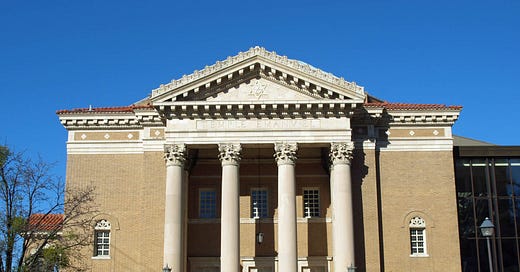The Day a Southern City Laid a Synagogue’s Cornerstone Together
A story of memory, faith, and the civic act of showing up
In the heat of July 1886, something remarkable happened in Birmingham. A marching band played. Dignitaries paraded through the streets. A crowd gathered to lay the cornerstone of Temple Emanu-El, the city’s first synagogue.
When they arrived at the site at 5th Avenue and 17th Street North, the area filled with onlookers from across the city. Many of them were not Jewish. The Grand Master of the Alabama Masons, John G. Harris, addressed the crowd with pride. Christians, Jews, and civic leaders spoke about the congregation’s bright future. A time capsule was sealed beneath the stone, filled with synagogue documents, local and national newspapers, and a roster of the Hebrew Ladies Aid Society.
Temple Emanu-El in Birmingham, Alabama. Dedicated in 1913, this building replaced the 1886 synagogue described in the essay. Non-Jews contributed $5,000 toward its construction.
Photo by Chris Pruitt, CC BY-SA 3.0, via Wikimedia Commons.
The orator that day captured a sentiment that still echoes, if we choose to hear it: "Should we not rejoice with each other in erecting institutions consecrated to the work of lifting nearer to God our neighbors and our friends?"
Alabama is not often remembered as a place of interfaith pluralism, particularly in the late 19th century, but this story reveals a more complex narrative. Today, as interfaith ties are under strain across the country, and as we approach the 250th anniversary of America’s founding, stories like this one remind us of a civic spirit worth recalling—and of a South where, for generations, people had the choice to show up across lines of difference. Sometimes, they did.
Birmingham wasn’t alone. These weren’t isolated gestures. They reflected a broader pattern.
Across Alabama, synagogue dedications often became public, communal milestones. While profoundly imperfect—reflecting the racial segregation of their time—these gatherings still offer something enduring through their public and interfaith nature. In Mobile, the state’s first synagogue, Sha'arai Shomayim (Gates of Heaven), was dedicated in 1846 in a former church. When the congregation moved into a new building in 1853—Alabama’s first purpose-built synagogue—city officials and Christian clergy attended the dedication. Many Jewish congregants stood so their guests could sit, and English translations of the service were offered to make the ceremony accessible.
In Montgomery, the city’s first Jewish services in the 1840s drew Gentiles as well as Jews from surrounding towns. In 1902, Temple Beth Or, a successor to this early religious community, dedicated a synagogue along Clayton Street. A choir from St. John’s Episcopal Church joined the Jewish congregation in song, and people of “all creeds and classes” were reported to have attended.
In Selma, Huntsville, and Demopolis, synagogue dedications before 1900 were similarly public. Christian ministers were often invited to speak. Local businesses closed. City officials gave addresses. In Gadsden in 1923, an Episcopal priest welcomed attendees at Beth Israel’s dedication, a public service attended by many across faiths. This same spirit didn’t vanish. In 1960, Baptist and Methodist clergy were guests at the dedication of a new synagogue wing.
But that 1960 dedication ended in tragedy—reminding us that even moments of hope can be pierced by violence. A 16-year-old firebombed the Beth Israel synagogue during the event and shot two people as they exited, wounding them. That, too, is part of the story—a reminder that goodwill and hatred have long coexisted, and that this struggle is far from over.
As a Jewish writer and historian, I’ve spent years tracing the histories of synagogues—especially in small towns across the South and Midwest. These stories are often overlooked or flattened into simplified narratives. The deeper I dig, the more I see that Alabama has long offered examples of civic welcome—rooted in places where, from 1850 until after 1970, synagogues—where they existed—stood as the only non-Christian houses of worship. These institutions were treated not merely with tolerance, but with honor.
Would we extend that same spirit today—to immigrants, to new neighbors, to those whose rituals may feel unfamiliar? These are questions not just of hospitality, but of identity. Who do we want to be? Perhaps the better question isn’t whether we still know how to welcome, but whether we still choose to honor welcome as a civic moment, not just a private virtue.
We can learn that the American promise of religious liberty was never meant to be passive. It was built—stone by stone, speech by speech, relationship by relationship. It shows us that civic pluralism isn’t some modern invention; it’s an inheritance we’ve long had the capacity to honor.
And we can ask: Do we still show up for each other’s sacred moments? Do we still celebrate our neighbor’s joy as a civic moment—not just a private ritual?
As Alabama, like the nation, faces new debates about belonging, we might see our past with new eyes. The fact that a synagogue in 1886 could draw an interfaith crowd, led by Masons and civic leaders, reminds us of who we have been—and who we still might be.
In that same cornerstone address in Birmingham, a non-Jewish speaker reflected: “Each step forward has been taken in civilization, in progress, in discoveries and in arriving at great truths, so, in proportion, has the human race learned to tolerate, to respect and admire the efforts of each other in building up institutions which make better men and better women.”
In the end, that’s what many synagogue dedications were in Alabama: moments when neighbors built something better, together. That memory is worth recovering—and retelling—not just for the Jewish South, but for all of us. Because unity isn’t a fantasy. It’s a choice—one our communities have made before.
P.S. If you know someone in Alabama—or anywhere—who might resonate with this story, feel free to share it. I’m grateful for every reader who helps recover these sacred moments of American pluralism.




